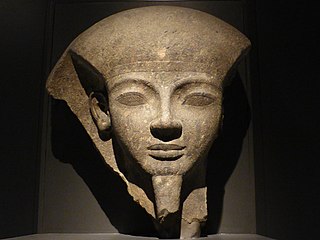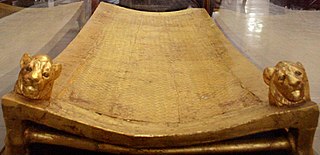
The Museum of Egyptian Antiquities, commonly known as the Egyptian Museum, located in Cairo, Egypt, houses the largest collection of Egyptian antiquities in the world. It houses over 120,000 items, with a representative amount on display. Located in Tahrir Square in a building built in 1901, it is the largest museum in Africa. Among its masterpieces are Pharaoh Tutankhamun's treasure, including its iconic gold burial mask, widely considered one of the best-known works of art in the world and a prominent symbol of ancient Egypt.

Zahi Abass Hawass is an Egyptian archaeologist, Egyptologist, and former Minister of State for Antiquities Affairs, serving twice. He has also worked at archaeological sites in the Nile Delta, the Western Desert and the Upper Nile Valley.

Menpehtyre Ramesses I was the founding pharaoh of ancient Egypt's 19th Dynasty. The dates for his short reign are not completely known but the timeline of late 1292–1290 BC is frequently cited as well as 1295–1294 BC. While Ramesses I was the founder of the 19th Dynasty, his brief reign mainly serves to mark the transition between the reign of Horemheb, who had stabilized Egypt in the late 18th Dynasty, and the rule of the powerful pharaohs of his own dynasty, in particular his son Seti I, and grandson Ramesses II.

The New Kingdom, also referred to as the Egyptian Empire, was the ancient Egyptian nation between the 16th century BC and the 11th century BC. This period of ancient Egyptian history covers the Eighteenth, Nineteenth, and Twentieth Dynasties. Through radiocarbon dating, the establishment of the New Kingdom has been placed between 1570 BC and 1544 BC. The New Kingdom followed the Second Intermediate Period and was succeeded by the Third Intermediate Period. It was the most prosperous time for the Egyptian people and marked the peak of Egypt's power.

Usermaatre Sekheperenre Ramesses V was the fourth pharaoh of the Twentieth Dynasty of Egypt and was the son of Ramesses IV and Duatentopet. His mummy is now on display at the National Museum of Egyptian Civilization in Cairo.

Ramesses VI Nebmaatre-Meryamun was the fifth ruler of the Twentieth Dynasty of Egypt. He reigned for about eight years in the mid-to-late 12th century BC and was a son of Ramesses III and queen Iset Ta-Hemdjert. As a prince, he was known as Ramesses Amunherkhepeshef and held the titles of royal scribe and cavalry general. He was succeeded by his son, Ramesses VII Itamun, whom he had fathered with queen Nubkhesbed.

Luxor Museum is an archaeological museum in Luxor, Egypt. It stands on the corniche, overlooking the east bank of the River Nile.

The Royal Cache, technically known as TT320, is an Ancient Egyptian tomb located next to Deir el-Bahari, in the Theban Necropolis, opposite the modern city of Luxor.

Tomb KV1, located in the Valley of the Kings in Egypt, was used for the burial of Pharaoh Ramesses VII of the Twentieth Dynasty. Although it has been open since antiquity, it was only properly investigated and cleared by Edwin Brock in 1984 and 1985. The single corridor tomb is located in Luxor's West Bank, and is small in comparison to other tombs of the Twentieth Dynasty.

The Michael C. Carlos Museum is an art museum located in Atlanta on the historic quadrangle of Emory University's main campus. The Carlos Museum has the largest ancient art collections in the Southeast, including objects from ancient Egypt, Greece, Rome, the Near East, Africa and the ancient Americas. The collections are housed in a Michael Graves designed building which is open to the public.

The Table Rock Welcome Centre is a retail and observation complex located in Niagara Falls, Ontario, Canada at the brink of the Canadian Horseshoe Falls, several hundred feet south of the former rock formation which bears its name. The complex consists of two buildings connected by an indoor pedestrian mall and anchored by "The Grand Hall", a multi-level indoor observation complex, completed in 2008.
Thomas Barnett was a museum proprietor, collector and innkeeper who managed museums and other tourist attractions in Niagara Falls, Ontario. Barnett was born near Birmingham, England and moved to Canada in the 1820s.

Exhibitions of artifacts from the tomb of Tutankhamun have been held at museums in several countries, notably the United Kingdom, Soviet Union, United States, Canada, Japan, and France.

Ramesses II, commonly known as Ramesses the Great, was an Egyptian pharaoh. He was the third ruler of the Nineteenth Dynasty. Along with Thutmose III of the Eighteenth Dynasty, he is often regarded as the greatest, most celebrated, and most powerful pharaoh of the New Kingdom, which itself was the most powerful period of ancient Egypt. He is also widely considered one of ancient Egypt's most successful warrior pharaohs, conducting no fewer than 15 military campaigns, all resulting in victories, excluding the Battle of Kadesh, generally considered a stalemate.

Bird Kingdom is an aviary in the tourist district of Niagara Falls, Ontario, Canada. Opened in May 2003, it is the largest free flying indoor aviary in the world. The attraction encompasses approximately 45,000 square feet (4,200 m2), and houses over 350 birds, the majority of which come from Australia, South America, and Africa. It is also home to mammals, reptiles and amphibians which are part of educational programs. Bird Kingdom has been voted a top family attraction in Niagara Falls and was inducted into the Trip Advisor Hall of Fame in 2016.

Queen Victoria Park is the main parkland located in Niagara Falls, Ontario, Canada opposite the American and Canadian Horseshoe Falls. Established by the Niagara Falls Park Act in 1885 and opened in 1888, the park is operated by the Niagara Parks Commission and is considered the centerpiece of the Niagara Falls recreational tourist area.

The Department of Egyptian Antiquities of the Louvre is a department of the Louvre that is responsible for artifacts from the Nile civilizations which date from 4,000 BC to the 4th century. The collection, comprising over 50,000 pieces, is among the world's largest, overviews Egyptian life spanning Ancient Egypt, the Middle Kingdom, the New Kingdom, Coptic art, and the Roman, Ptolemaic, and Byzantine periods.

The National Museum of Egyptian Civilization (NMEC) is a large museum located in Old Cairo, a district of Cairo, Egypt. Partially opened in 2017, the museum was officially inaugurated on 3 April 2021 by President Abdel Fattah El-Sisi, with the moving of 22 mummies, including 18 kings and four queens, from the Egyptian Museum in central Cairo, in an event termed the Pharaohs' Golden Parade. The museum displays a collection of 50,000 artifacts, presenting the Egyptian civilization from prehistoric times to the present day.
William Jamieson was a Canadian treasure and antique dealer and reality TV star. Jamieson was also known as the Headhunter. He was the star of History Channel's Treasure Trader. He was also a world-famous dealer of tribal art, described as having "a taste for the bizarre", and as "Indiana Jones meets Gene Simmons". He was also described as a treasure hunter who "is Indiana Jones, minus the rolling boulders, aliens and savage tribesmen".
Sahar Saleem is a professor of radiology at Cairo University where she specialises in paleoradiology, the use of radiology to study mummies. She discovered the knife wound in the throat of Ramesses III, which was most likely the cause of his death.

















